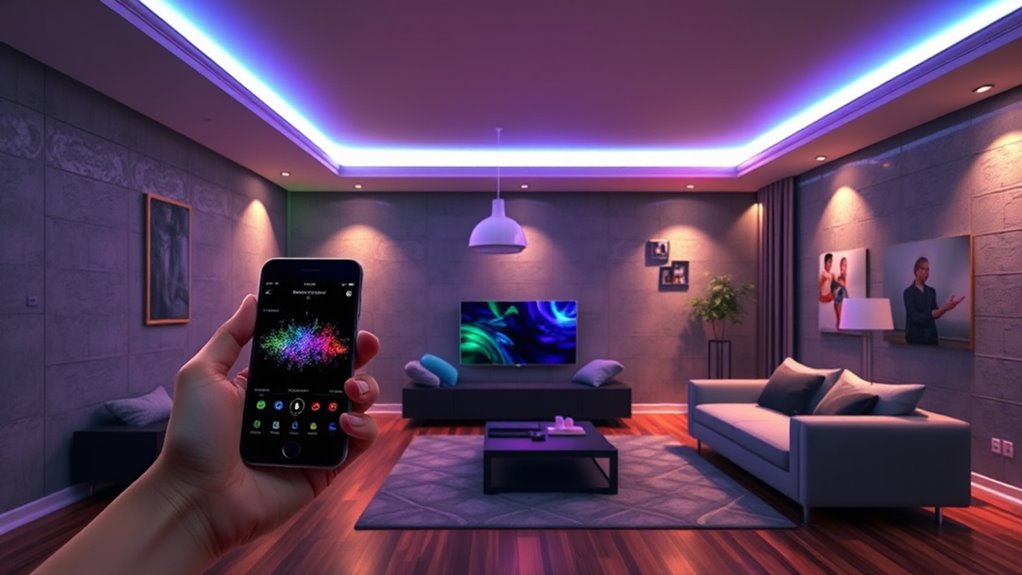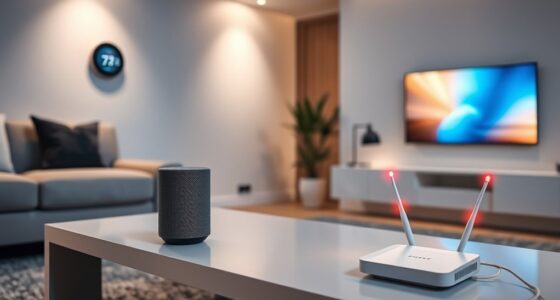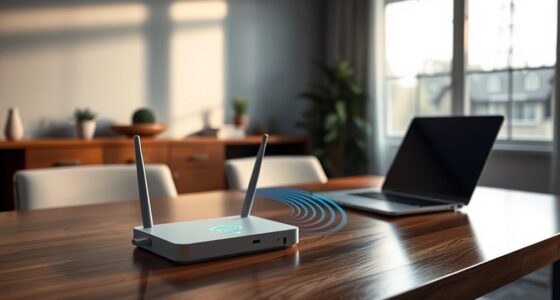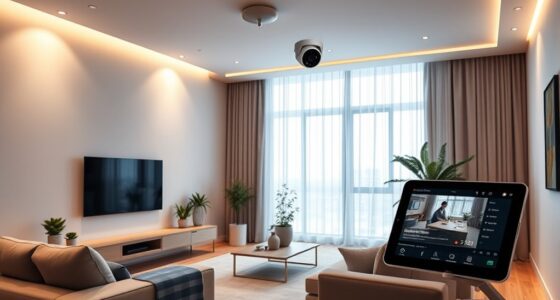The hidden feature of smart lights that will blow your mind is their ability to mimic presence, deter intruders visually with flashing alarms, and create immersive scenes using dynamic effects. You can customize flashing patterns, set schedules, and synchronize multiple lights for stunning displays. These features turn your home into a safer, more vibrant space. Keep exploring to discover how combining these tricks can transform your smart lighting experience in surprising ways.
Key Takeaways
- Advanced security modes like Mimic Presence automate lighting to simulate occupancy, deterring intruders silently.
- Customizable flashing light patterns can mimic emergency signals or police sirens for effective intruder deterrence.
- Dynamic light effects such as flickering, pulsing, and natural phenomena create immersive, mood-enhancing environments.
- Synchronizing multiple lights and effects via community apps enables complex, large-scale visual displays and alerts.
- Hidden features unlock powerful automation, blending security, ambiance, and sensory experiences seamlessly.
Mimic Presence Mode: Making Your Home Look Occupied
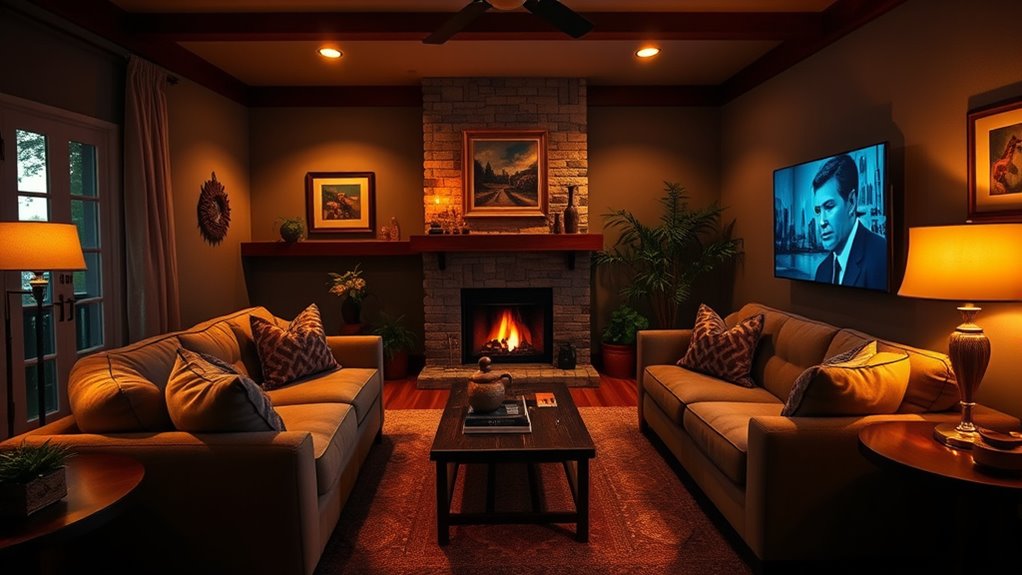
Mimic Presence Mode helps you make your home look occupied by automatically controlling your smart lights to simulate activity. By mimic presence, your smart lights turn on and off in patterns that mimic real occupancy, which enhances home security and deters burglars. You can set this feature to run all day or only during dark hours, giving you flexible automation options. To activate, simply select the rooms and lights in your automation system, then configure a schedule or trigger controls. You can manually start or stop mimic presence mode using smart buttons or widgets for added convenience. This feature offers an effective security layer without needing extra hardware like cameras or alarms, making your home appear lively and monitored at all times. Additionally, understanding home automation can help you customize and optimize your security strategies further. Incorporating smart light patterns can further enhance the realism of your occupancy simulation and make your setup even more convincing. Being aware of privacy and cookie usage ensures your automation remains secure and your data protected.
Light Alarms: Using Lights to Deter Intruders Visually

Light alarms use flashing or strobing lights to scare off intruders and alert you visually, providing a silent security boost. You can customize the flashing patterns and colors, making them adaptable to different situations. This approach enhances security without creating noise, helping to deter burglars effectively. Additionally, incorporating timing and pattern variations can increase the effectiveness of the lights in startling intruders and preventing break-ins. Implementing AI-powered security analytics can further optimize the use of light alarms by adapting their patterns based on real-time threat detection. Using advanced motion sensors can also improve the responsiveness of the system, ensuring lights activate only when necessary to conserve energy and avoid false alarms. Moreover, understanding vetted safety products ensures that the technology used is both safe and reliable for your home security needs. Leveraging insights from private equity market trends can guide investments in innovative security technologies to stay ahead of emerging threats.
Visual Intruder Deterrence Strategy
Using flashing or pulsating lights, such as white or red, can effectively deter intruders by creating a sudden, noticeable visual alert. This is a key component of the visual deterrence strategy with smart lighting. Light alarms can be triggered automatically by motion or contact sensors, instantly activating flashing scenes that catch an intruder’s eye. When integrated with security cameras like Hue Secure, these lights can synchronize with sensor activity for real-time alerts. To maximize effectiveness, consider these approaches:
- Automate light alarms to flash during suspicious activity, increasing visibility.
- Use smart lighting to create unpredictable flashing patterns, confusing intruders.
- Combine with security cameras to enhance visual deterrence and record activity.
This simple yet powerful tactic leverages existing smart lighting hardware for immediate, cost-effective security. Additionally, utilizing smart light scheduling can ensure that the flashing patterns operate at optimal times to further deter potential intruders, and understanding the capillary action in smart lighting can help optimize the timing and intensity of flashing sequences. Moreover, being aware of Halloween celebrations around the world can inspire creative themed lighting to surprise intruders and boost home security during festive seasons.
Customizable Light Flashing Patterns
Customizable flashing patterns allow homeowners to tailor visual deterrents to their specific security needs. With smart light bulbs, you can set up customizable light flashing patterns that act as effective security alerts. These patterns can be automated to trigger when sensors detect motion or door activity, creating immediate visual warnings. You can program specific sequences, like rapid flashes of white or red lights, to mimic emergency signals or police sirens, making intruders think twice. Advanced automation lets you adjust the speed, duration, and color of the flashes, providing a personalized and highly effective deterrent. By integrating customized flashing patterns into your automated lighting system, you enhance your home’s security without relying solely on alarms or noise, making your property less attractive to intruders. The importance of effective security measures is emphasized in various safety strategies, including visual deterrents like smart lighting. Additionally, utilizing smart home automation allows for seamless control and customization of these lighting patterns, further strengthening your security setup. A well-designed system can also include privacy considerations, ensuring your security measures do not compromise your personal data or comfort.
Enhancing Security Without Noise
Ever considered how flashing lights can serve as a silent yet effective security measure? Smart lights provide a powerful way to enhance security through visual alerts that deter intruders without noise. When an alarm activates, lights can automatically flash in patterns supported by devices like Hue Secure cameras or contact sensors. This disruptive visual cue draws attention and signals that your property is protected. You can set automations to trigger these visual alerts based on sensor activity, such as door openings or motion detection in dark areas. Incorporating visual deterrents like flashing lights is a proven method to increase security effectiveness without creating noise disturbances. Utilizing vertical storage solutions and other organization tactics can also support a more secure environment by reducing clutter that might hide intruders. Additionally, implementing offensive security measures like these visual alerts can help prevent attempted break-ins before they escalate. For example, integrating smart lighting with security protocols enhances overall safety by providing immediate, visible responses to suspicious activity. Creating a comprehensive security system that combines visual alerts with other measures can further strengthen your home’s defenses. Here are three ways smart lights boost security without noise:
- Create noticeable flashing patterns to scare off intruders.
- Use automated triggers for instant visual alerts.
- Customize timing and effects for discreet, effective deterrence.
This approach keeps your security discreet yet impactful.
Fade Duration: Creating Smooth Transitions for Mood and Routine
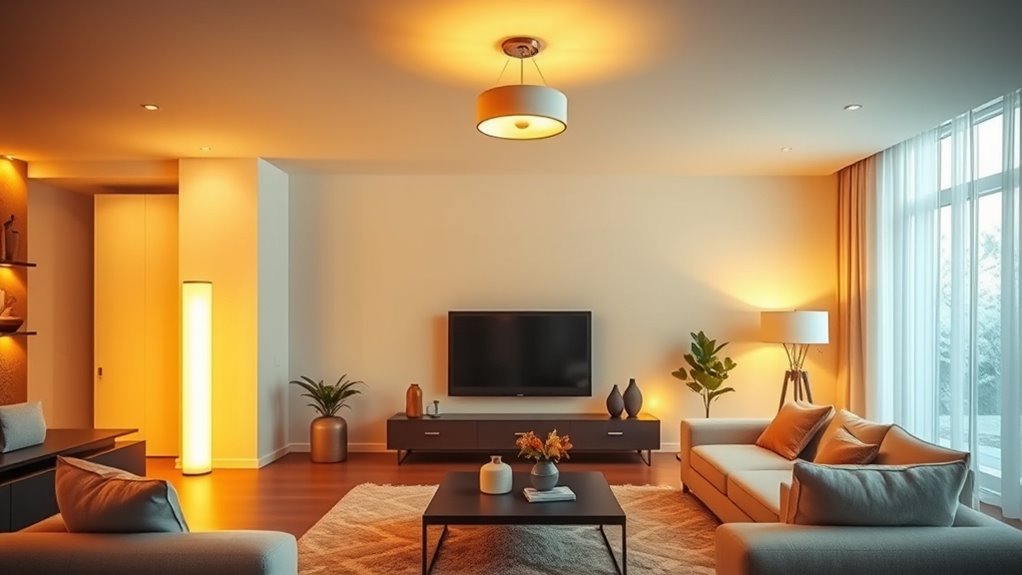
Adjusting the fade duration in your smart lighting automations allows you to create seamless shifts between brightness levels, enhancing the ambiance of any room. With customizable fade times, you can set the lighting to gradually brighten or dim over periods from 5 minutes to an hour, making routines like waking or winding down more natural. Longer fade durations, such as 30 minutes, mimic sunrise or sunset, providing a calming effect. This feature adds a professional touch, making lighting changes smooth and aesthetically pleasing. Here’s a quick overview of fade duration options:
| Fade Duration | Ideal Use | Effect |
|---|---|---|
| 5-15 minutes | Quick adjustments | Slight transition |
| 15-30 minutes | Morning wake-up or winding down | Gentle brightening/dimming |
| 30-60 minutes | Sunrise/sunset simulation | Slow, natural transition |
Dynamic Light Effects: Adding Movement and Atmosphere
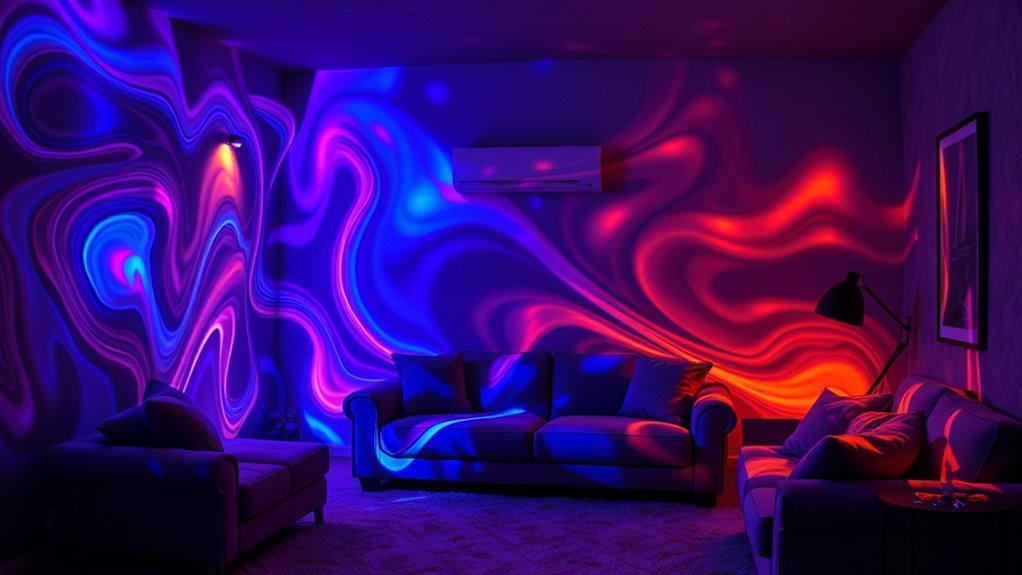
You can transform any space with dynamic light effects that add movement and atmosphere. Customizable flickering patterns, rhythmic pulsing, and natural phenomenon simulations let you create mood and realism effortlessly. These effects make your lighting experience more immersive and tailored to any occasion.
Customizable Flickering Patterns
Many smart lights offer customizable flickering patterns that let you add movement and atmosphere to your space. These lighting effects can mimic natural phenomena like candle flames, thunderstorms, or shimmering water, instantly transforming any environment. With the right app or automation, you can create and save unique flickering scenes tailored to your mood. Here’s what you can explore:
- Adjust flicker speed, brightness, and color to match your desired ambiance.
- Sync lighting effects with music or events for an immersive experience.
- Use third-party apps or custom scripts to generate complex, animated flickering sequences.
This feature empowers you to craft dynamic atmospheres effortlessly, making your smart lights more versatile and expressive.
Rhythmic Pulsing Effects
Rhythmic pulsing effects bring your smart lights to life by creating dynamic, moving patterns that mimic natural rhythms like breathing or a heartbeat. With scene effects and animation, you can easily set up rhythmic pulsing to enhance your space’s atmosphere. These effects adjust brightness and color in a rhythmic pattern, adding movement and energy to static lighting. Many smart lighting systems allow you to customize pulse speed, intensity, and hue, giving you full control over the vibe. You can activate pulsing manually, schedule it to run automatically, or sync it with music and sound for an immersive experience. Advanced features even let your lights respond to sensors or triggers, creating a responsive environment that adapts seamlessly to your activity and mood.
Natural Phenomenon Simulations
Natural phenomena like flickering flames, shimmering water, and twinkling stars can be vividly recreated with smart light effects, transforming static illumination into dynamic, immersive environments. You can enhance any scene by using customizable light effects to mimic nature’s beauty. Here are three ways these effects elevate your space:
- Create realistic candle flames or fireplace scenes that flicker and glow naturally.
- Simulate ocean waves or underwater scenes with shimmering, rhythmic water effects.
- Reproduce starry nights with twinkling effects that add depth and ambiance.
Animated Light Scenes: Bringing Your Lighting to Life
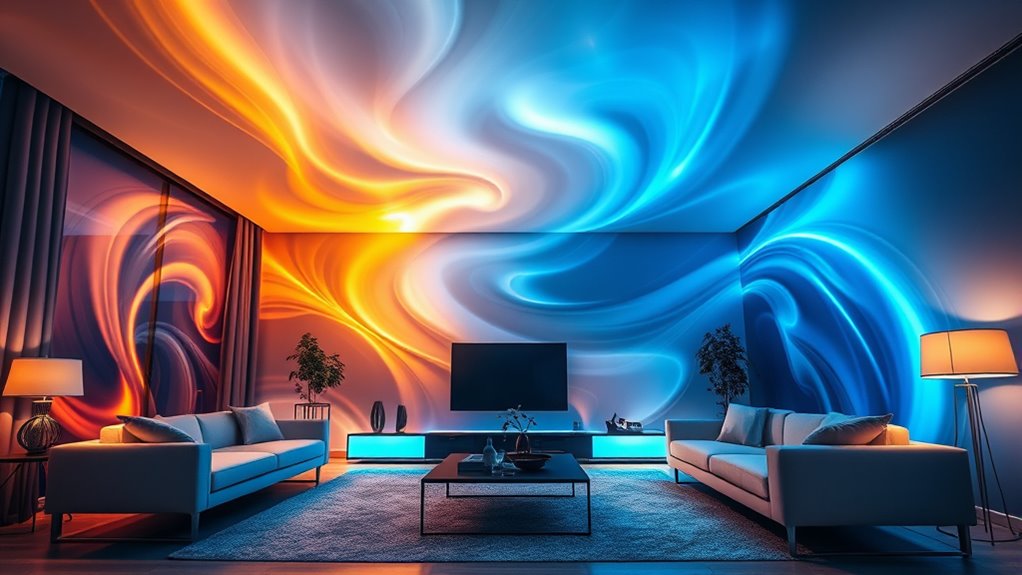
Animated light scenes transform your smart lighting into a dynamic display by adding movement and visual interest. With scene animations, you can activate effects like pulsing, shimmering, or rhythmic color changes by simply tapping the Play icon. These effects mimic natural phenomena, creating a vibrant, immersive experience. You can customize effects by adjusting brightness, color, and speed, tailoring each scene to your mood or setting. Whether you want a lively atmosphere or a calming environment, animated light scenes bring your space to life with motion-inspired visuals. Once you’ve set your favorite animations, save them for quick access anytime. This seamless blend of automation and manual controls makes your smart lighting smarter, more engaging, and uniquely yours.
Light Timers: Automating Scenes With Delays and Schedules
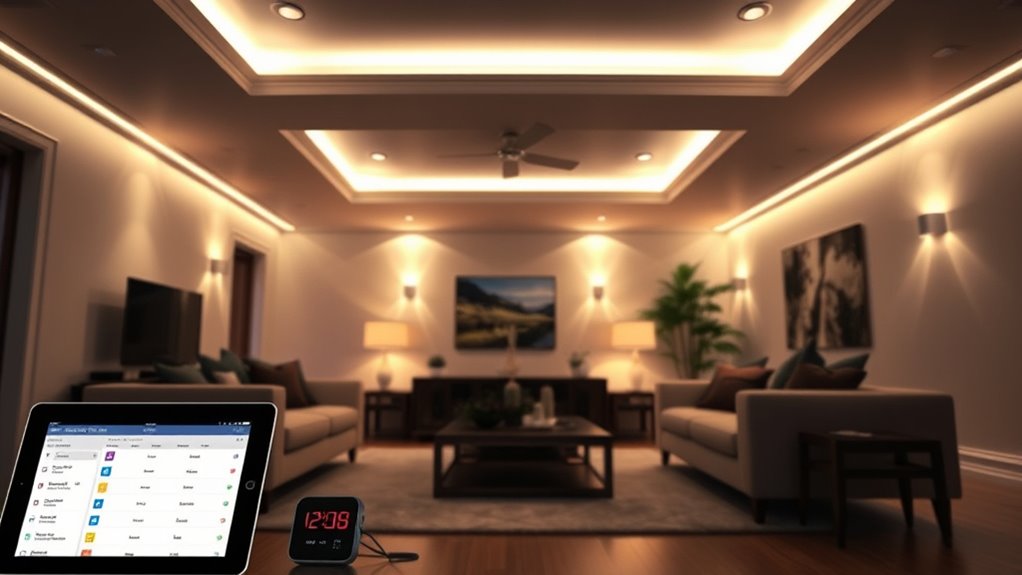
Building on the vibrant effects of animated light scenes, light timers give you even more control by scheduling when your scenes activate. With light timers, you can set delays ranging from 1 minute to 24 hours, automating scenes effortlessly. This means you can schedule your outdoor lights to turn on at dusk or hallway lights to activate just before you wake up, making routines seamless. You can trigger these timed scenes by pressing the Play button within automation settings, offering flexible scheduling options for your smart home. To deepen your automation, consider these features:
- Precise control over scene activation times
- Enhancing security and energy efficiency
- Creating dynamic, mood-enhancing lighting routines
Creating Custom Effects With Community Apps and Integrations

Community apps and integrations open up a world of possibilities for customizing your smart lighting effects beyond basic scenes. With tools like iconnecthue, you can craft unique custom effects such as color loops, flashing sequences, or synchronized music displays that go beyond standard options. Using platforms like WebCoRE or IFTTT, you can automate complex lighting effects—think smooth progressions, pulsations, or dynamic color shifts triggered by specific events or schedules. Many third-party apps support advanced animations, including flickering, shimmering, and pulsing effects that mimic natural phenomena or festive themes, all customizable with adjustable speed, brightness, and colors. Community resources and tutorials make it easy to develop personalized lighting effects, allowing you to enhance your home automation with stunning, tailored lighting effects that fit your style.
Synchronizing Multiple Lights for Stunning Visual Displays
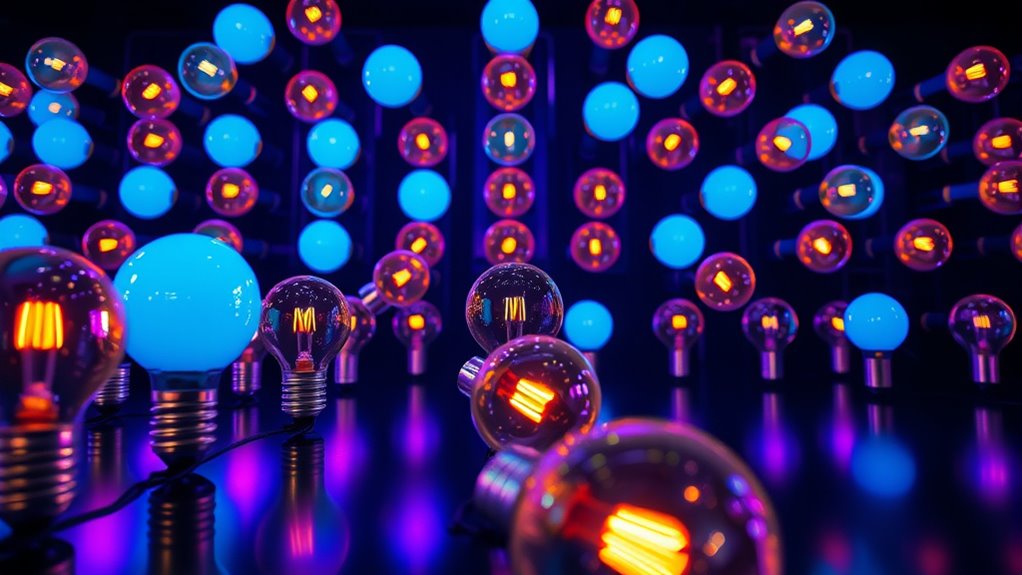
Synchronizing multiple smart lights can transform any space into a mesmerizing light show. By linking your color smart bulbs through apps like Philips Hue’s native sync, third-party options like iConnectHue, or automation platforms like SmartThings, you can create stunning lighting effects. Imagine coordinating over 100 lights for large-scale displays that captivate everyone. With advanced automation tools like WebCoRE, you can design complex sequences—flashing, shimmering, or rhythmic color changes—across your entire setup. Here are some ideas to get you started:
- Create synchronized color transitions for parties or movie nights.
- Use lighting effects to signal alerts or updates.
- Program pulsing or shimmering effects for immersive ambiance.
Combining Features for an Immersive Smart Lighting Experience
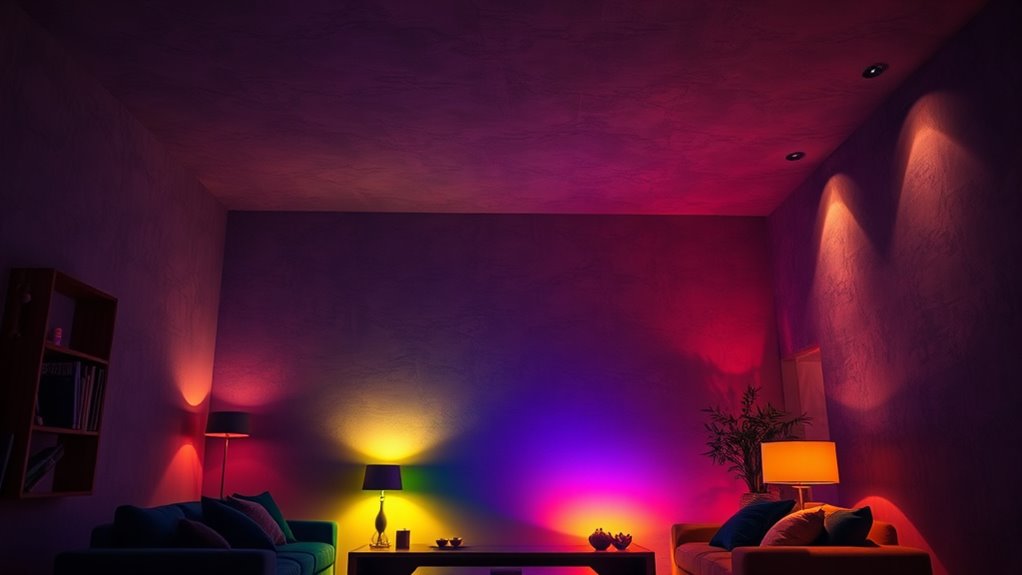
By combining animated scenes, light effects, and timers, you can craft dynamic and immersive lighting experiences that mimic natural phenomena or set lively moods. Using scene automation, you can synchronize fade durations with animated effects, creating seamless transitions that enhance your home’s ambiance and mood lighting. Integrating multiple sensor triggers allows for personalized, multi-sensory environments suited for different activities or times of day. Light effects like flashing alarms or mimic presence modes not only elevate the visual appeal but also boost security by simulating occupancy. Leveraging advanced automation tools such as WebCoRE or third-party apps enables highly customized setups, making your smart lights truly immersive. With these features combined, you access a new level of control, transforming ordinary lighting into a fascinating, sensory-rich experience.
Frequently Asked Questions
What Are the Risks of Smart Lighting?
Smart lighting offers convenience, but it also comes with risks. You might unknowingly leave your network vulnerable to hacking if your systems aren’t secure. Your lights could collect your habits, raising privacy concerns. Firmware gaps or reliance on cloud services can cause outages or security issues. Plus, misconfigured settings might create safety hazards or let malicious actors take control. Stay vigilant, update regularly, and secure your network to minimize these risks.
Do Smart Lights Raise the Electric Bill?
Ever wonder if those fancy smart lights secretly drain your wallet? Well, surprise! They actually help lower your electric bill. By consuming just 4 to 10 watts, and with automation features to turn off when not needed, you save energy and money. So, instead of sneaky charges, you get smarter lighting that saves you cash while making your home look cool. Who knew saving money could be so high-tech?
What Is the Smart Light Feature?
The smart light feature lets you do much more than turn lights on and off. You can create dynamic effects like flickering, pulsing, shimmering, or animated scenes that set the mood or entertain. With adjustable colors, brightness, and speed, you customize your lighting experience. You can activate these effects manually or set them to run automatically, making your space more immersive and visually mesmerizing.
Can Smart Lights Be Controlled Remotely?
Controlling smart lights remotely is like having a magic wand at your fingertips. You can turn them on or off, change colors, or dim them from anywhere with an internet connection. Using dedicated apps, voice commands, or third-party platforms, you stay in control even when you’re away. Just make certain your system has a stable Wi-Fi connection, and you’re all set to manage your lighting effortlessly from anywhere.
Conclusion
Did you know that smart lighting can reduce energy consumption by up to 40%? By exploring features like Mimic Presence Mode and dynamic effects, you can make your home safer, more stylish, and energy-efficient. When you combine timers, custom scenes, and synchronized displays, your space becomes truly immersive. Embrace these hidden features, and you’ll not only elevate your home’s ambiance but also enjoy smarter, more sustainable living every day.
